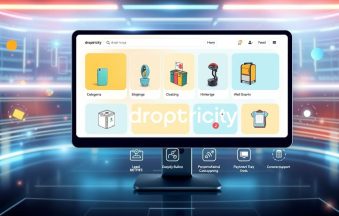International dropshipping has become a popular way for entrepreneurs to start an e-commerce business without holding inventory. This business model allows online stores to sell products globally, leveraging suppliers and logistics to handle everything from inventory management to shipping. In this guide, we’ll explore how international dropshipping works, its benefits, challenges, and tips for success, all while keeping things simple and approachable.
What is International Dropshipping?
International dropshipping is a retail method where an online store sells products without physically stocking them. Instead, when a customer places an order, the store purchases the item from a supplier, who then ships it directly to the customer.
What makes it “international” is the global reach—suppliers might be in one country, the store in another, and customers in yet another. This model relies heavily on a smooth supply chain and efficient logistics to ensure timely delivery.
The beauty of dropshipping lies in its low startup costs. Entrepreneurs don’t need to invest in inventory upfront, making it an attractive option for those looking to break into e-commerce without a big budget. However, success requires careful planning, especially when dealing with cross-border operations.
Benefits of International Dropshipping
Low Startup Costs and Flexibility
One of the biggest draws of international dropshipping is the minimal financial risk. Since there’s no need to purchase inventory in advance, entrepreneurs can launch an online store with relatively low investment. This model also offers flexibility in product selection, allowing sellers to test different niches without committing to large stock purchases.
Access to a Global Marketplace
With international dropshipping, businesses can reach customers worldwide. By partnering with suppliers in various countries, an online store can offer a diverse range of products, from electronics to fashion, catering to different markets. This global reach opens up endless opportunities for sales and growth.
Simplified Inventory Management
Since suppliers handle inventory and warehousing, dropshippers can focus on marketing, customer service, and building their brand. This streamlined approach reduces the complexity of managing stock, making it easier to scale an e-commerce business.

Challenges of International Dropshipping
Navigating Customs and Shipping Issues
Cross-border shipping can be tricky. Customs regulations vary by country, and unexpected duties or delays can frustrate customers. Long shipping times, especially from distant suppliers, can also impact customer satisfaction. To mitigate this, dropshippers should choose reliable logistics partners and communicate clear delivery expectations.
Managing Profit Margins
While startup costs are low, profit margins in international dropshipping can be slim due to shipping costs, customs fees, and competition. Dropshippers need to carefully price their products to cover costs while remaining competitive in the marketplace.
Ensuring Quality Control
Since dropshippers don’t handle products directly, ensuring consistent quality can be a challenge. A poor-quality item or slow delivery can lead to negative customer reviews, damaging the brand’s reputation. Partnering with reputable suppliers and requesting product samples can help maintain quality standards.
Tips for Success in International Dropshipping
Choose the Right Niche and Suppliers
Selecting a profitable niche is crucial. Research market trends to identify products with high demand and low competition. Once a niche is chosen, vet suppliers carefully. Platforms like AliExpress, Oberlo, or Spocket can connect dropshippers with reliable partners. Look for suppliers with good ratings, fast shipping options, and responsive customer support.
Optimize Your Online Store
A user-friendly online store is the backbone of any e-commerce business. Use platforms like Shopify or WooCommerce to create a professional-looking site. Ensure the store is easy to navigate, mobile-friendly, and optimized for SEO to attract organic traffic. Clear product descriptions, high-quality images, and transparent shipping information can boost conversions.
Focus on Marketing and Branding
Effective marketing is key to standing out in a crowded marketplace. Use social media, email campaigns, and paid ads to drive traffic to your store. Building a strong brand identity, with a unique logo and consistent messaging, helps create trust and loyalty among customers.
Prioritize Customer Service
Exceptional customer service can set a dropshipping business apart. Respond promptly to inquiries, provide clear return policies, and keep customers informed about order status. Even in cross-border transactions, proactive communication can enhance customer satisfaction and encourage repeat sales.
Monitor Analytics and Adapt
Use analytics tools to track sales, website traffic, and customer behavior. Platforms like Google Analytics or Shopify’s built-in tools can provide insights into what’s working and what isn’t. Adjust product selection, pricing, or marketing strategies based on data to improve conversions and profit margins.
Tools and Platforms for International Dropshipping
Several platforms simplify the dropshipping process. AliExpress is a popular choice for sourcing products due to its vast selection and global suppliers. Oberlo integrates seamlessly with Shopify, automating order fulfillment and inventory updates. Spocket focuses on suppliers from the US and EU, offering faster shipping times for certain markets. For payment processing, PayPal and Stripe are reliable options that support cross-border transactions.

Common Mistakes to Avoid
Overlooking Shipping Times
Long shipping times can lead to unhappy customers. Be upfront about delivery timelines and consider working with suppliers who offer ePacket or expedited shipping options to reduce wait times.
Ignoring Customer Reviews
Customer reviews are critical for building trust. Encourage buyers to leave feedback and address negative reviews professionally to maintain a positive brand image.
Neglecting SEO and Analytics
Without proper SEO, an online store may struggle to attract visitors. Similarly, ignoring analytics can prevent dropshippers from optimizing their marketing efforts or identifying underperforming products.
Conclusion
International dropshipping offers a low-risk, flexible way to enter the e-commerce world. By choosing the right niche, partnering with reliable suppliers, and focusing on customer satisfaction, entrepreneurs can build a successful online store. While challenges like customs, shipping times, and profit margins exist, careful planning and strategic marketing can lead to a thriving business. With the right tools and mindset, anyone can tap into the global marketplace and achieve e-commerce success.













Add comment